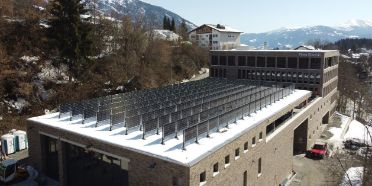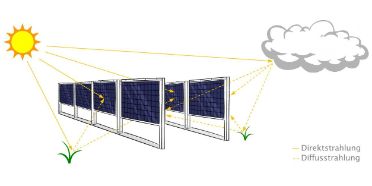Manual for bifacial, vertical photovoltaic systems
The bifacial vertical photovoltaic handbook is a technical planning aid for vertically installed, bifacial PV systems for the Swiss Plateau and alpine areas.
Factsheet
- Lead school School of Engineering and Computer Science
- Institute Institute for Energy and Mobility Research IEM
- Research unit IEM / Photovoltaic systems
- Funding organisation Schweizerische Eidgenossenschaft (Bundesverwaltung)
- Duration (planned) 01.01.2021 - 28.02.2022
- Project management Prof. Dr. Christof Bucher
- Head of project Prof. Dr. Christof Bucher
-
Project staff
Matthias Hügi
Sebastian Tobias Koch - Partner Bundesamt für Energie BFE
- Keywords Bifacial vertical, electricity production, midlands/alpine dimensioning, decentralised power supply, yield simulation
Situation
PV systems on house roofs usually have a module inclination that optimises the energy yield in summer or all year round. As a result, the systems produce little energy in winter, when a lot of energy is needed, among other things for heating. Vertically installed systems can remedy this situation. Such systems can be installed in open spaces or on flat roofs. In alpine areas, they can achieve a significant increase in energy production due to snow, high albedo values and the near absence of fog. This handbook presents dimensioning diagrams for bifacial, vertical PV systems on the Swiss Plateau and in the alpine areas. On the one hand, the effect of inter-row spacing on the yield per surface and the specific yield has been examined. On the other hand, the losses due to curtailment are shown in relation to the nominal power ratio.
Course of action
Two locations were chosen for the creation of the dimensioning graphics. Burgdorf, a typical location on the Swiss Plateau, and Gütsch, a typical alpine location. At both locations, energy yields for various design cases were determined with the help of a predefined sample system and a simulation tool. The orientation of the system and the inter-row spacing varied. The subsequent calculations were used to determine the energy yield, the yield per surface and the specific yield in different seasons. Values were determined for the entire year, the summer semester, the winter semester and the winter months. When calculating the curtailment losses, the amount of energy loss at different nominal power ratios was investigated. The nominal power ratio describes the relationship between the power of the inverter (AC output) and the standardised module output under STC.
Result
Various dimensioning graphics for the two locations are presented in the manual. The yield graphs show the course of the energy yield over the year with different inter-row spacings. The specific yield graphs show the energy yield standardised with the existing system output. The graphs with the yield per surface reflect the potential energy yield that can be achieved per surface with the simulated system. The specific yield and the yield per surface are analysed with regard to the inter-row spacing. The graphs on the curtailment losses show the losses that occur with different ratios of inverter output and module output. The manual is available in German and in French.
Looking ahead
The manual can now be used in practice. Due to the continuous further development of simulation programmes with regard to bifaciality and direct or diffuse radiation, further possibilities will be available in the future for the simulation of such systems.


